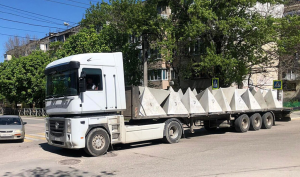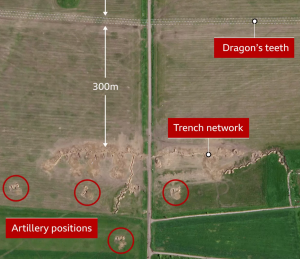The Impending Ukrainian Counterattack

The Russians threatened a year round attack on Ukraine promising a robust winter offensive that failed to materialize and what fighting did occur took a bloody and disproportionate toll on Russian combat power. Essentially, the Ukrainians gave up little to no territory and exacted a massive price in Russian blood.
The Russians, during the winter, unleashed a terrific missile attack nightly on Ukrainian civilian targets that has been substantially negated by the addition of Western anti-air assets, most particularly the US Patriot missile system.
The Russians used hypersonic missiles that were routinely defeated by the Patriot thereby piercing the bubble of Putin’s braggadocios invulnerability.
What happens next, Big Red Car?
It is obvious the Ukrainians have spent the winter building new attack brigades — the fundamental building block of division oriented western fighting forces — while gathering new equipment and training to attack the Russians to drive them out of Ukraine.
The training by combat experienced allies and Ukrainians is the key to the Ukrainian success. The gear is important, but the training is what will make the Ukrainians victorious.
The Russians, meanwhile, have been digging in and creating defensive lines in depth in the east, the southeast, and the south (Crimea). Where once it had been unthinkable to consider Ukraine expelling the Orcs from Crimea, now it is on everybody’s dance card.
How good are the Russian defenses?
After sixteen months at war — a very long week in Russian minds — the Orcs have rounded into shape in a few areas — electronic warfare and anti-drone operations — and have made no progress, even regressing, in others.
One of the areas in which the Russians appear to be hopelessly inadequate is the arena of physical defense. Defense is a tough assignment in the Russian army as it means going to ground and digging in. It is highly immobile and a lack of mobility on a modern battlefield is fatal.
The Russian defense in depth — imagine parallel bands of defense — looks something like this:
1. A wide approach area that is under constant artillery attack by the Russian defenders with direct forward observer and drone observation;
2. A quarter-mile wide minefield in front of the first physical obstacle, the anti-tank ditch;
3. An anti-tank ditch to deny tanks easy passage;
Another minefield of approximately a quarter mile in depth;
A double, triple, quadruple row of six feet tall reinforced concrete dragon’s teeth;
Another minefield of approximately a quarter mile in depth;
The main line of occupied resistance wherein Russians soldiers are dug into the terra firma.
That’s it. The minefields may not materialize because of the sheer magnitude of the challenge.
Here’s a satellite photo of a typical Orc defensive layout.
What will the Ukrainians do, Big Red Car?
The problem with the Orc approach — other than its obvious World War I flavor — is the Ukrainians have observed them and the Ukrainians have trained to breech each of those elements.
If the Russian concentrate their artillery to shell the approach, the Ukrainians will fire superior targeted counter-battery fire with the usual types of howitzers, guns, and mortars, but also weapons like HIMARS with pinpoint accuracy from beyond the artillery fan of the Russians.
When the Ukrainians confront the first minefield, they will use tank mounted flails and other weapons to breach the minefield and gain access to the anti-tank ditch which they will defeat by simply using push blades mounted on engineer tanks (the German Pionierpanzer 2A1 Dachs armored engineer vehicle, the Norwegian armored engineer vehicle, and MBTs equipped with a combat engineer blade) to cut down the edges, fill the interior, and doze a way out of it.
To watch the video at full size, place your cursor over start arrow at the middle of the video and then put your cursor on the box in the upper right corner and click.
The Ukrainians can also use any of six different tactical scissor bridges they possess to bridge the anti-tank ditch.
The Ukrainians, once past the anti-tank ditch, will again use their tank mounted flails to breach the minefields arriving at the dragons’ teeth that any of these armored engineer vehicles can simply push out of the way using their fore mounted blade. There are numerous videos of Ukrainian and western armored engineer vehicles doing just that.

Orc Dragons Teeth being transported by Russians to deploy in Ukraine as anti-tank obstacles. Notice how relatively small they are. The Dragons Teeth will not be even remotely effective.
Once the Ukrainians have cleared pathways through the obstacles and confront the main line of resistance, the Ukrainians will pour through these breaches with infantry and tanks and destroy these lines of resistance.
In western military theory, one must have a 3:1 local advantage to carry the day in the specific area to be attacked. This will not be difficult for the Ukrainians to achieve in the areas selected for their breaching operations.
Once the Russian defenses are breached, the fight becomes a mobile fight and the Russians are particularly inept at this type of warfare.
When the Ukrainians breach and pour through these obstacles, the Russian troops in their fortifications are essentially surrounded and no longer combat effective.
One must believe the Russians possess reserve forces behind the main line of resistance.
Bottom line it, Big Red Car
OK, dear reader, here it is:
1. The Orcs have gone to ground with elaborate deep defensive infrastructure that looks formidable, but is well within the capabilities of Ukraine gear to breach.
2. The Ukrainians are in no hurry to launch their summer offensive as they continue to receive weapons and train up what will be the equivalent of 3-5 divisions with potent and lethal gear.
The superiority of the western gear cannot be overstated.
3. When the Ukrainians attack, expect them to deploy deception and to try to fool the Russians as to where the main attack(s) are coming.
4. The Russian defensive lines when breached will initiate a mobile attack and a pursuit type of warfare which is a Russian weakness. The Russian reserves will have to make big bets that if wrong will ensure their destruction.
5. The Ukrainians will attack in several locations and, like astute tacticians, will exploit those efforts that result in breakthroughs and abandon those efforts that are not as immediately successful.
6. The Ukrainians will simultaneously strike several major blows — knock out the Kerch bridge to Crimea or hit the Russian Black Sea fleet — to support their attack.
7. The Ukrainians will achieve initial success in several locations, Russian resistance will stiffen, and the Ukrainians will pour through the locations where the Russians are struck a killing blow.
Do not be surprised if the Ukrainians conduct several feints to disguise their intentions.
8. I think the Ukrainians will be wildly successful and the Russians will be humiliated, but there will be some Russian success at isolated locations.
9. Once the Ukrainians have the Russians retreating, the battle will become a decisive engagement meaning the destruction of one army or another will happen.
The retreating Russians will become the most dangerous moment in the war to date as Putin is left with no real likelihood to win the war and may resort to nuclear weapons. That would be perfectly consistent with Russian military doctrine.
But, hey, what the Hell do I really know anyway? I’m just a Big Red Car.





